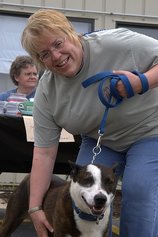 I love Petfinder. It’s a wonderful way for animals in need to find new homes. I’ve described the site as being like an online dating site, but to connect humans with companion animals instead of humans with humans. I hate Petfinder. There are so many animals who need new homes that going on the site can be depressing for me. I want to help them all. My husband was on Petfinder a couple of weeks ago looking at dogs and he ran across a 15 year-old American Eskimo dog in South Carolina. The rescue group was charging a $150 adoption fee. My first reaction was overwhelming sadness that a dog that old has no home. I know intellectually there are senior animals across the country who need to be placed so this one dog is not unique. My second reaction was to the adoption fee. I told Rich that the rescue should screen adopters, but should just give the dog away. Really. The plight of this one dog rumbled around in my head for weeks and ended up colliding with a lot of other thoughts about how rescue groups function in their seemingly never ending quest to place animals in new homes. Those in rescue are some of the hardest working people on the planet. Most work full-time jobs and do rescue on the side as a labor of love, being paid absolutely nothing in the process. I call you Rescue Warriors. There are some bad apples out there who do terrible things while masquerading as rescues, but I’d like to think that most groups are genuine and have the best of intentions. Having said that, I think that there are things that rescues either do or fail to do which drastically limits their effectiveness and that’s the subject of this blog. I hope that if you run a rescue group or you work with a rescue group in some capacity you will at least consider my input. I admit that I am an outsider looking in, I cannot possibly appreciate all the challenges you face and that my suggestions may not be welcome. I really do mean no offense. I think I just see some of these things from a different perspective as both an animal welfare advocate and a potential adopter. In making my suggestions, I fully recognize that most rescues function with only volunteer labor and that tasks are spread out among a number of people. My suggestions are aimed toward rescue groups which are nonprofits with 501(c)(3) status. If you are in rescue and do not have that status, please work on that. There are many steps to get your nonprofit status, but the online filing options available now make the process move much faster and it costs a lot less than it did just a couple of years ago. Your adoption listings should be detailed, compelling and kept up to date. Whether you list your animals on Petfinder, on Adopt A Pet or on Rescue me (or all three sites), your listing is your sales pitch for the animal. There are a lot of articles out there on how to write good content so that it is positive and compelling. Please do a little homework on how to best describe your animals in ways which help the reader "meet" the animal using a computer or phone. Not only should you describe the animal in positive ways, but include enough detail so an adopter knows the approximate age and approximate weight. Some adopters are looking for animals of a particular size due to their lifestyle or their own age. There are a lot of adoption listings which say so little that people really don’t look at them long and just click the "back" button to move on. The value of good images can also not be understated in your listings. An image of the animal looking happy and who is in a friendly environment will always get more response than a sad or depressing image of an animal in a kennel or looking away from the camera. Finally, make sure you keep your listings updated. If your initialing listing says the animal is undergoing some treatment or in need of some rehabilitation, make sure you update the listing later so that the potential adopter is getting the most current information on the pet and understands his or personality. Petfinder listings may take a little time to develop with the help of volunteers who write descriptions and take photographs for you, but is it worth every minute to market your animals effectively. Relax your adoption standards to make them reasonable. Nathan Winograd of the No Kill Advocacy Center wrote an article years ago which was later included in his book, "Irreconcilable Differences: The Battle for the Heart and Soul of America’s Animal Shelters" as a chapter called Good Homes Need Not Apply. The gist of the chapter is that some rescue groups make their standards so high that really good adopters are turned away. Of course you want your animals to go to good homes and live fully and healthy lives. This means, however, that you need to consider adopters on a case-by-case basis and not judge them all the same. Arbitrary rules like not adopting out animals to homes with young children, not adopting animals to couples who are not married or not adopting out a dog to a family that doesn’t have a fenced yard simply keep perfectly good adopters away and limit your ability to place animals. In the almost 20 years I have lived in Alabama, we have lived in two separate places, neither of which were fenced because they encompassed acres of land. Our dogs have never been outside unsupervised and both lived more than 16 years. Yet many rescue groups may not adopt to us now because we don’t have a fully fenced yard. Find creative ways to raise money so you are not relying on your adoption fees to cover costs. I know that helping animals costs a lot of money. Some of the animals taken in by rescues require thousands of dollars of veterinary care to treat injuries, skin conditions or even heart worms. All of the animals have to be fully vetted and must be spayed or neutered before being adopted out. But please do not rely on your adoption fees to cover your costs. There are a host of ways to fund-raise to get money coming in regularly to help offset your costs. Do shirt fund raisers with a company like Bonfire which requires no cost output, produces great shirts and helps you brand your organization at the same time. Consider ordering custom vehicle magnets from a company like Magnet America. You can purchase high quality vehicle magnets for a small price and sell them for 5 times what you paid for them while branding your organization. Organize a “no budget” event like a dog walk at a local park and raffle off donated items. Consider doing a cyber auction using a Facebook page or a website like Bidding for Good. You can invite supporters to list items in your auction virtually and then those supporters ship the item to the winning bidder once the auction ends with no cost to you. Those are just some ideas. There is a great book called Funds to the Rescue which may give you some ideas you haven’t thought of before. And when in doubt, network with other rescues you believe do a good job raising money and just ask them how they do it. Seek out business sponsorships and grants. Another way to keep money coming in regularly is to take advantage of business sponsorships. Simply approach a business you think may be willing to give you a one-time donation each year and ask if they are interested in sponsoring your organization with a tax deductible in exchange for having their name and logo appear on your website. Even businesses which have nothing at all to do with animals appreciate the value of exposure and having positive public opinion about them. If you have ever decided to use a business because you knew it was animal friendly or supported animal causes, you have seen this process in action. Related to businesses, you can also see if you can persuade them to either cover all adoption fees in a particular month or all spay and neuter costs in a particular month. If you can find just one business to do this one time, it will allow you to later challenge another business to do that same. As far as grants go, there are many to be had. I am told that grant writing is a skill and it is not one that I possess. If you have a volunteer who is computer savvy and who likes a challenge, have them do some searing for both national and regional grant opportunities and consider sending the volunteer to a grant writing class. Many large organizations like Petsmart Charities offer grants, but so do local organizations you may never have heard of before. In the city where I work, there is a biomedical business that gives out annual grants and many of them go to animal shelters and rescue groups. 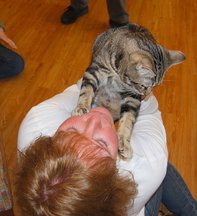 Rethink your adoption fees. I wrote a blog about adoption fees and what they mean in December of 2016 so I won’t restate the whole blog here. Adoption fees should be a way to offset some of your costs, but should not be the only way you cover costs. Please remember that you are in the business of marketing animals to get them into new homes and the focus should be on the placement itself, not the purchase price. If your adoption fees are too high, you price yourself out of the market. I have seen some fees so high that people go to a breeder instead and that’s just a terrible shame. In the process of writing this blog and searching on Petfinder, I found a rescue group close to me which charges an adoption fee of $450 for some dogs and which claims those fees are tax deductible*. I really do wonder how many people will pay that much in my area. Charge some nominal fee if you have to or consider waiving the fee entirely in at least some cases. I encourage waived adoption fees for adoptions of senior pets, adoption of pets to seniors and adoption of pets to veterans. I also encourage to waive the fee for any harder to place animal whether it is a special needs animal or just an animal you have had for a longer period of time that other animals. As I wrote in my prior blog about this, the adoption fee has nothing at all to do with the value of the animal. When you waive that fee, you are saying that the animal’s life is worth more than the fee you would have charged. You absolutely still have to screen adopters. I’m just saying that the fee itself should not be the focus. (*Adoption fees are not tax deductible because the person giving you money is getting something in return. If you have low or waived adoption fees, you can then encourage people to donate toward your organization and those funds would be tax deductible.) Have a fully functioning website. Social media is a wonderful tool to help place rescue animals. Please just do not make it your only tool. Although most people have computers, laptops, tablets or smart phones, there really are a lot of people out there who "don’t do" social media. Even those who do use social media are not focused on a lot of the content. News feed items come and go and while people may "like" your Facebook page, they are surely not checking it daily. In order to market your animals and reach more people, you need a fully functioning website that looks polished and which contains all the information you want people to know about your organization, your animals, your fund raising, your events, etc. There are a variety of companies you can use to get a domain name and then host your site for very little money. I moved my sites to Weebly a couple of years ago and I recommend it highly. It is easy to create a website quickly with no prior experience and you may very well have a volunteer who can develop and manage your website for you for very little money. Be visible and not invisible. Your rescue group may be the most important thing in your life, but if people don't know about your group then you are not important to them at all. You may be an island in your community and your region even if you have a fully functioning website and Facebook page. You have to be proactive to get your organization on the public radar. Think in terms of how to set yourself apart from other groups in your area. Brand yourself and the name of your rescue group through t-shirt drives, by selling vehicle magnets and hosting periodic events (even if they are low budget or no budget events). Check with a local billboard company to see if they offer a nonprofit rate particularly on electronic billboards which can be much cheaper than static billboards. Try connecting with movers and shakers within your community - people of influence who run businesses or may have some celebrity status - to see if you can get them on board to support your rescue in some way by attending a function or by doing a PSA for you to appear on television. If there are dozens of rescues in your area you simply have to find a way to make yourself stand out and to do it consistently and in a positive way so that people know your name. Don’t forget to use the media. One of the areas where I think most rescues miss out is use of the media. If you are having an event, do a press release and send it to local television stations and radio stations. Also consider doing a PSA (public service announcement) about your event or just about your rescue group in general. It is not difficult to create a PSA using a computer and some software and it is not difficult to develop relationships with local TV and radio stations. We see nonprofit advertising on television all the time from The Ad Council and other nonprofit organizations. There is no reason you cannot create a PSA for your group and get it aired; it will not air in prime time when paying ads run but any exposure through television is a plus. The same is true for radio. Some radio stations are owned by large corporations which make it hard to get air time. Most communities, however, have at least one locally owned and managed radio station which will allow you either submit a PSA or which will work with you to record a PSA. Just this month I prepared a television PSA for nonprofit group about an adoption event and I recorded a PSA at a local radio station about a "Chipathon" in which people could get pets microchipped for reduced prices. I don’t have any special skills on this subject beyond what any rescuers have. You just have to take advantage of the opportunities out there by being fearless. (images, sound file and video clip courtesy of Petfinder, Inc.; Dana Kay Mattox Deutsch; Southern Skies Labrador Rescue & Adoption Inc.; Becky Lyn Tegze, Fun 92.7 and A New Leash on Life, Inc.)
1 Comment
Please stop what you’re doing and do a search on your phone or computer for this: "Dog by Dog" This will lead you to the website for a compelling documentary film about the commercial dog breeding industry and the subject of "puppy mills" which has been getting more and more attention these days. The film is now available on Netflix, iTunes, Amazon, Youtube, Vudu and Google Play. There are some materials which I consider compulsory viewing or reading for any animal welfare advocate, any person who cares about companion animals or any person who is interested in how we spend money in our country at federal, state and local levels. "Dog by Dog" is must see viewing as far as I’m concerned. I first blogged about Dog by Dog last August prior to public release of the film and I called it a game changer akin to "The Cove" or "Blackfish." I was fortunate enough to get a Q&A session with Chris Ksoll, the film's Executive Producer. Now that the film has been released for all to see and I have seen it myself, I felt it was important for me to talk about this film again and to implore people to watch it. I have long believed that if we could get the American public paying attention to what takes place in our country related to the subject of the commercial dog breeding industry and related to puppy mills in particular, people would be so outraged that they would demand change. We Americans love our dogs to extent we could even be called "dog snobs." We hold the values of our culture higher than the values in some other cultures where dogs as used solely for utility purposes or where dogs are consumed. We are appalled at places and by people who don’t share our values, as if those people are less evolved than we are. But just how evolved are we really? It’s hard to stake a claim on the moral high ground when we produce millions of dogs each year while we destroy millions of dogs each year in places we dare call "shelters." "Dog by Dog" introduces us to subjects we’re not used to hearing about related to puppy mills: money, power interests and legislation. Unlike some footage many of us have seen regarding puppy mills, this is not an "in your face" film that overwhelms you with disturbing images which will keep you awake at night. It is more of a thinking person’s film which helps us understand the topic logically and pragmatically while introducing us to some incredibly important people who are working really, really hard to change our society. And while I would hope what you see does not keep you up at night, I hope what you learn completely changes your opinion on this subject and compels you to get involved.  • We hear from people like Bill Smith of Main Line Animal Rescue who appeared on the Oprah Winfrey show in 2008 and effectively put the phrase "puppy mill" on the public radar. Bill has an excellent quote in the early portion of the film where he compares the way we house mill dogs to strapping them into seats on a 747 and making them live there for 8 years. • We hear from Bob Baker, the Director of the Missouri Alliance for Animal Legislation, who helps us understand what happened to legislation in Missouri to regulate mills which was opposed by powerful and influential forces, but which ultimately led to enactment of the Canine Cruelty Prevention Act. 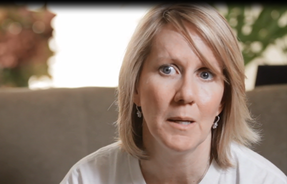 • We hear from Bob’s counterpart in Ohio, Mary O’Connor Shaver, a long-time contact of mine whom I hold in very high regard. Mary leads Ohio Voters for Companion Animals and she is on the front lines of fighting puppy mills in her state through public awareness and by advancing legislation. • We hear from people in the "weeds" of rescue like Mindi Callison of Bailing Out Benji who protests puppy mills weekly in an effort to educate the public and while saving mill dogs. • We learn about the incredibly powerful influence of the American Kennel Club related to dog breeding and the regular opposition of the AKC to common sense legislation to regulate that breeding. • And we learn about the staggering influence of "Big Agriculture" interests which fight incredibly hard to thwart legislation which would serve to help dogs using the "domino reasoning" that the legislation about dogs would surely lead to legislation about cows, pigs and chickens. In order to give more depth to this follow-up blog about the film, I solicited some input from three of the people you will see in the film. I would like to offer my heartfelt thanks to Christopher E. Grimes, Bob Baker and Mindi Callison for taking the time to answer some questions for me. Christopher E. Grimes, Director of Dog by Dog Q: What is the one thing that shocked you most about the subject of puppy mills during the course of producing the film? Bob Baker, Director, Missouri Alliance for Animal Legislation Q: Even though Proposition B (covered extensively in the film) was altered after the public vote, are you satisfied with the changes created by the legislation? Mindi Callison, Founder, Bailing Out Benji Q: There have been a number of documentary films made about the puppy mill industry. What do you think separates "Dog by Dog" from those other films? If you have not seen this film, I simply cannot urge you strongly enough to take 88 minutes out of your life to see it. The power to end puppy mills and regulate the commercial dog breeding industry rests with us. Yes, us. Mills will exist as long as we keep buying the products and until we learn about the incredibly powerful forces at work in our society that keep the industry alive and thriving. You will surely walk away from viewing the film wondering why in the world the mass production of dogs is even legal in America considering our otherwise progressive culture. (images courtesy of "Dog by Dog") |
AuthorI am an animal welfare advocate. My goal is to help people understand some basic issues related to companion animals in America. Awareness leads to education leads to action leads to change. Archives
July 2024
Categories
All
image courtesy of Terrah Johnson
|
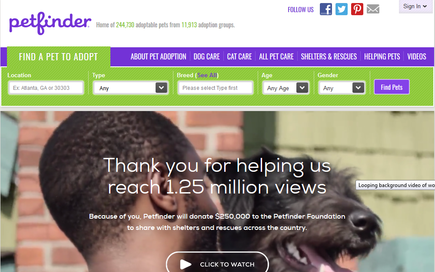
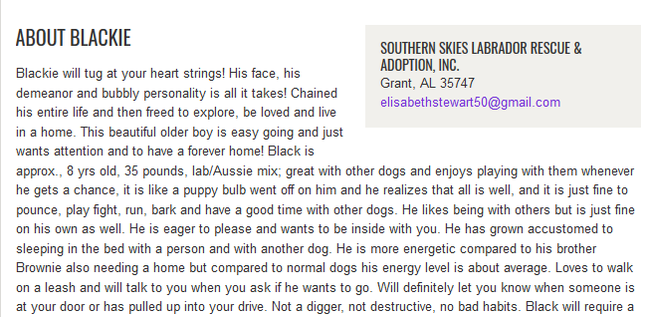

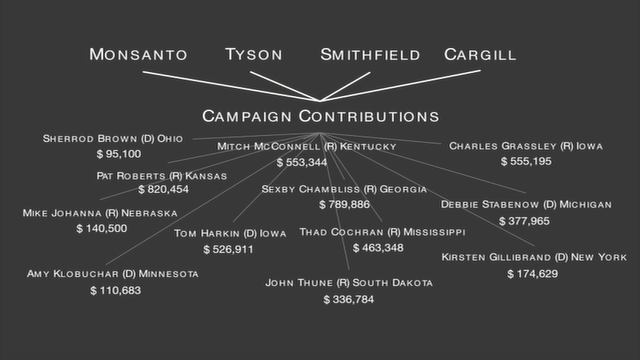
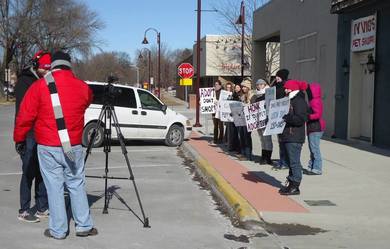
 RSS Feed
RSS Feed